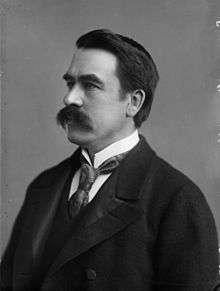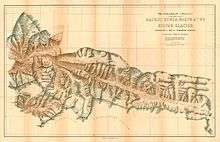Martin Conway, 1st Baron Conway of Allington
| The Lord Conway of Allington | |
|---|---|
 Conway in 1895 | |
| Born |
April 12, 1856 Rochester, Kent |
| Died |
April 19, 1937 (aged 81) London |
| Nationality | English |
| Other names | Martin Conway |
| Occupation | Art critic, politician, mountaineer |
| Children | Agnes Conway |
William Martin Conway, 1st Baron Conway of Allington (12 April 1856 – 19 April 1937), known between 1895 and 1931 as Sir Martin Conway, was an English art critic, politician, cartographer and mountaineer.
Background and education
Conway was born at Rochester, England, on 12 April 1856, the son of Reverend William Conway, who later became rector of St. Margaret's, Westminster.[1][2] He was educated at Repton and Trinity College, Cambridge,[3] where he studied mathematics and became a close friend of Karl Pearson. He became interested in woodcuts, engraving and early printed books; his History of the Woodcutters of the Netherlands in the Fifteenth Century was published in 1884.
Mountaineering
Conway was a member of the Alpine Club, of which he was president from 1902 to 1904.[4]
In 1892, in the course of an exploring and mountaineering expedition undertaken under the auspices of the Royal Society, the Royal Geographical Society and the British Association, he made an ascent of a subsidiary summit of Baltoro Kangri, claiming a world altitude record with a height of 23,000 ft (7,010 m). However, subsequent measurements have revised his height to 22,322 ft (6,804 m).[5] In 1896–97 he explored the interior of Spitsbergen, and the following year he explored and surveyed the Bolivian Andes, climbing "Sorata" (known today as Ancohuma, 21,086 ft / 6,427 m) and Illimani (21,122 ft / 6,438 m). He also attempted Aconcagua (22,831 ft / 6,959 m) stopping short of the summit by 50-ft and explored Tierra del Fuego making an attempt on Sarmiento.[6] At the Paris exhibition of 1900 he received the gold medal for mountain surveys, and the Founders Medal of the Royal Geographical Society in 1905.
He served as President of the Alpine Club for 1902–04 and became the first president of The Alpine Ski Club at its inaugural meeting in 1908.
Academic career

From 1884 to 1887 Conway was Professor of Art at University College, Liverpool; and from 1901 to 1904 he was Slade Professor of Fine Art at Cambridge University. He was knighted in 1895 for his efforts in mapping 5,180 square km of the Karakoram Range in the Himalayas three years earlier.
In 1889 he published a book concerning his research on Albrecht Dürer. He was assisted in this by the polymath Lina Eckenstein who was the sister of a fellow mountaineer.[7]
Political career
Conway had been involved in politics for some time, consorting with both major parties allegedly in pursuit of a knighthood and a barony; he received both. He was mentioned as a possible liberal candidate for Wolverhampton South in early 1900, but withdrew his candidature 'owing to domestic circumstances'.[8] He was elected Unionist Member of Parliament for the Combined English Universities in 1918, serving until 1931, when he was raised to the peerage as Baron Conway of Allington, of Allington in the County of Kent, in the Dissolution Honours.[9][10]
Conway was first Director-General of the Imperial War Museum and a trustee of the National Portrait Gallery. His photograph collection formed the basis of the Conway Library at the Courtauld Institute of Art in London. He was also responsible for the restoration of Allington Castle.
He died in London on 19 April 1937.[11] The title became extinct on his death.
Works
Works on art
- History of the Woodcutters of the Netherlands in the Fifteenth Century, 1884
- Early Flemish Artists, 1887
- The Literary Remains of Albrecht Dürer, 1889
- The Dawn of Art in the Ancient World, 1891, dealing with Chaldean, Assyrian and Egyptian art
- Early Tuscan Artists, 1902
- Art Treasures of Soviet Russia, 1925
- Giorgione as a Landscape Painter, 1929
Mountaineering and travel works
- Climbing and Exploration in the KaraKoram Himalayas, 1894
- The Alps from End to End, 1895
- The First Crossing of Spitsbergen, 1897
- The Bolivian Andes, 1901
- Aconcagua and Tierra Del Fuego: A Book of Climbing, Travel and Exploration, 1902
- No Man's Land, a History of Spitsbergen from its discovery in 1596 to the beginning of the Scientific Exploration of the Country, 1906
- Mountain Memories, 1920
- "Palestine and Morocco", 1923
Autobiography
- Episodes in a Varied Life, 1932
- The Sport of Collecting, 1914
References
- ↑ Peter H. Hansen (2004). Conway, (William) Martin, Baron Conway of Allington (1856–1937). Oxford Dictionary of National Biography, Oxford University Press. (subscription required)
- ↑ "CONWAY, Sir (William) Martin". Who's Who. 59: 373. 1907.
- ↑ "Conway, William Martin (CNWY875WM)". A Cambridge Alumni Database. University of Cambridge.
- ↑
 Chisholm, Hugh, ed. (1911). "Conway, Sir William Martin". Encyclopædia Britannica (11th ed.). Cambridge University Press.
Chisholm, Hugh, ed. (1911). "Conway, Sir William Martin". Encyclopædia Britannica (11th ed.). Cambridge University Press. - ↑ Curran, Jim (1995). K2: The Story of the Savage Mountain. Hodder & Stoughton. p. 50. ISBN 978-0-340-66007-2.
- ↑ Unsworth, Walt (1993). Hold the Heights. Hodder & Stoughton. p. 197. ISBN 0-340-33913-6.
- ↑ Jane Chance (2005). Women Medievalists and the Academy. Univ of Wisconsin Press. p. 58. ISBN 978-0-299-20750-2.
- ↑ "Election intelligence". The Times (36061). London. 9 February 1900. p. 10.
- ↑ The London Gazette: no. 33772. p. 7409. 17 November 1931. Retrieved 8 January 2015.
- ↑ The London Gazette: no. 33778. p. 7905. 8 December 1931.
- ↑ The Complete Peerage, Volume XIII - Peerage Creations 1901-1938. St Catherine's Press. 1949. p. 500.
External links
| Wikimedia Commons has media related to Martin Conway, 1st Baron Conway of Allington. |
| Wikisource has original works written by or about: William Martin Conway |
- William Martin Conway and Egyptian Excavations
- Works by Martin Conway, 1st Baron Conway of Allington at Project Gutenberg
- Works by or about Martin Conway, 1st Baron Conway of Allington at Internet Archive
- Works by Martin Conway, 1st Baron Conway of Allington at LibriVox (public domain audiobooks)

- William Martin Conway; John Walter Gregory (1897). The First Crossing of Spitsbergen: Being an Account of an Inland Journey of Exploration and Survey, with Descriptions of several Mountain Ascents, of Boat Expeditions in Ice Fjord, of a Voyage to North-East-Land, the Seven Islands, down Hinloopen Strait, nearly to Wiches Land and into most of the Fjords of Spitsbergen and of almost complete circumnavigation of the Main Island. Charles Scribner's Sons.
- "Archival material relating to Martin Conway, 1st Baron Conway of Allington". UK National Archives.
| Parliament of the United Kingdom | ||
|---|---|---|
| New constituency | Member of Parliament for Combined English Universities 1918–1931 With: H. A. L. Fisher 1918–1926 Eleanor Rathbone 1926–1931 |
Succeeded by Sir Reginald Craddock Eleanor Rathbone |
| Peerage of the United Kingdom | ||
| New creation | Baron Conway of Allington 1931–1937 |
Extinct |